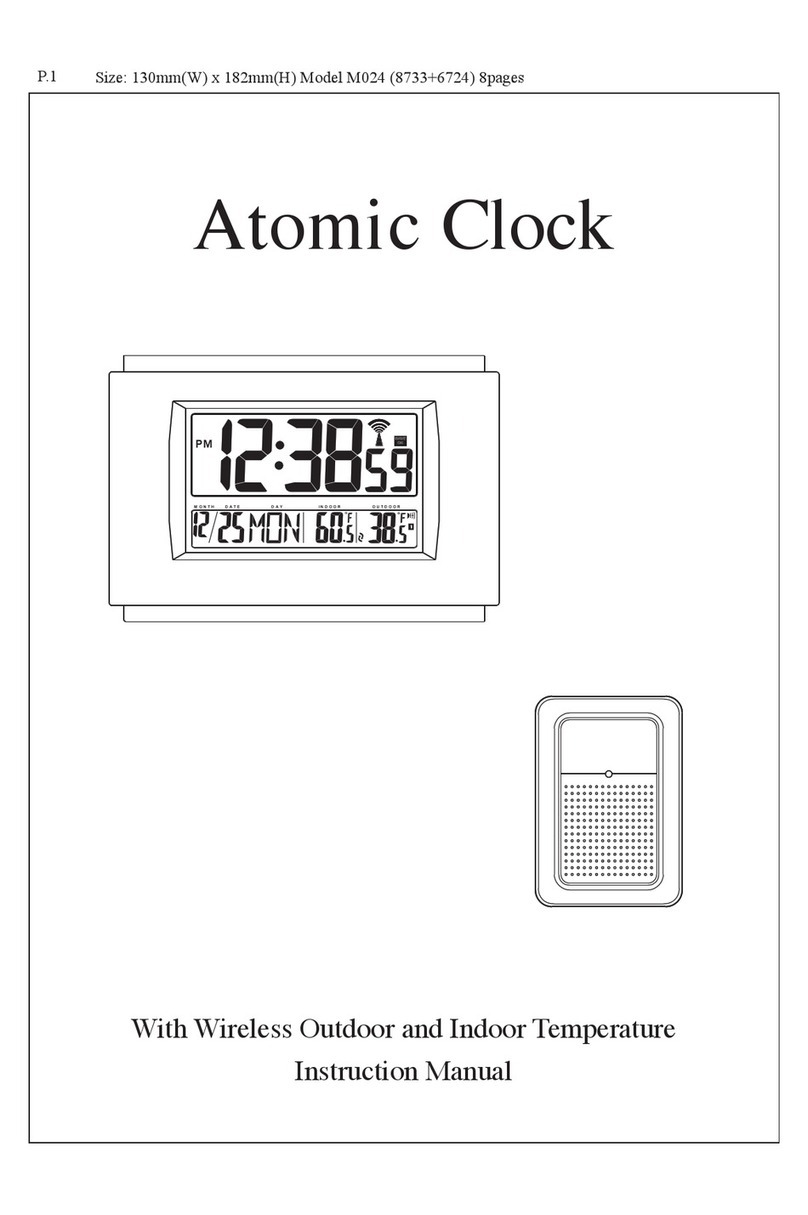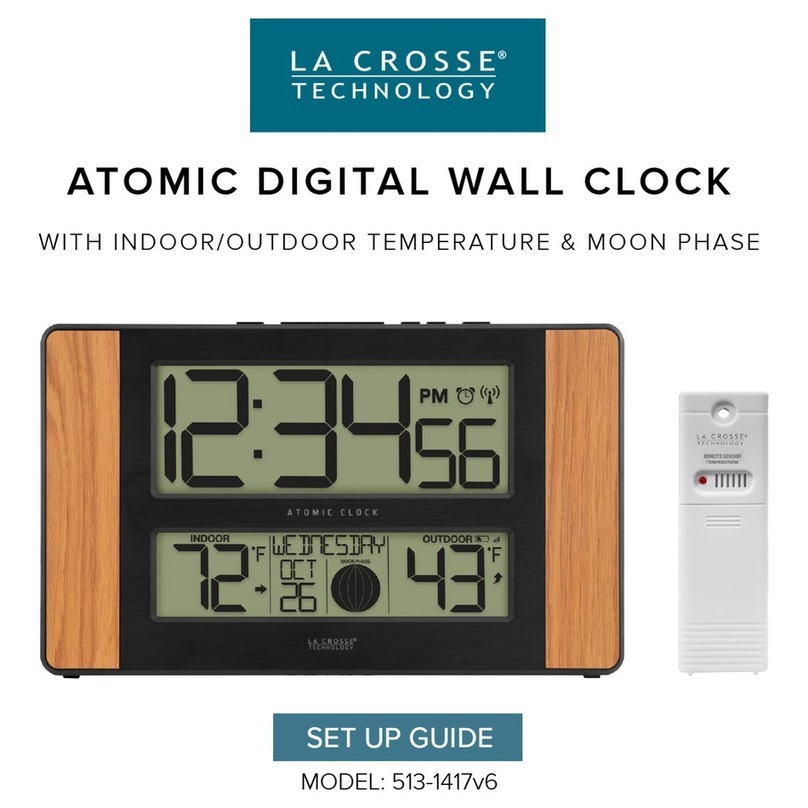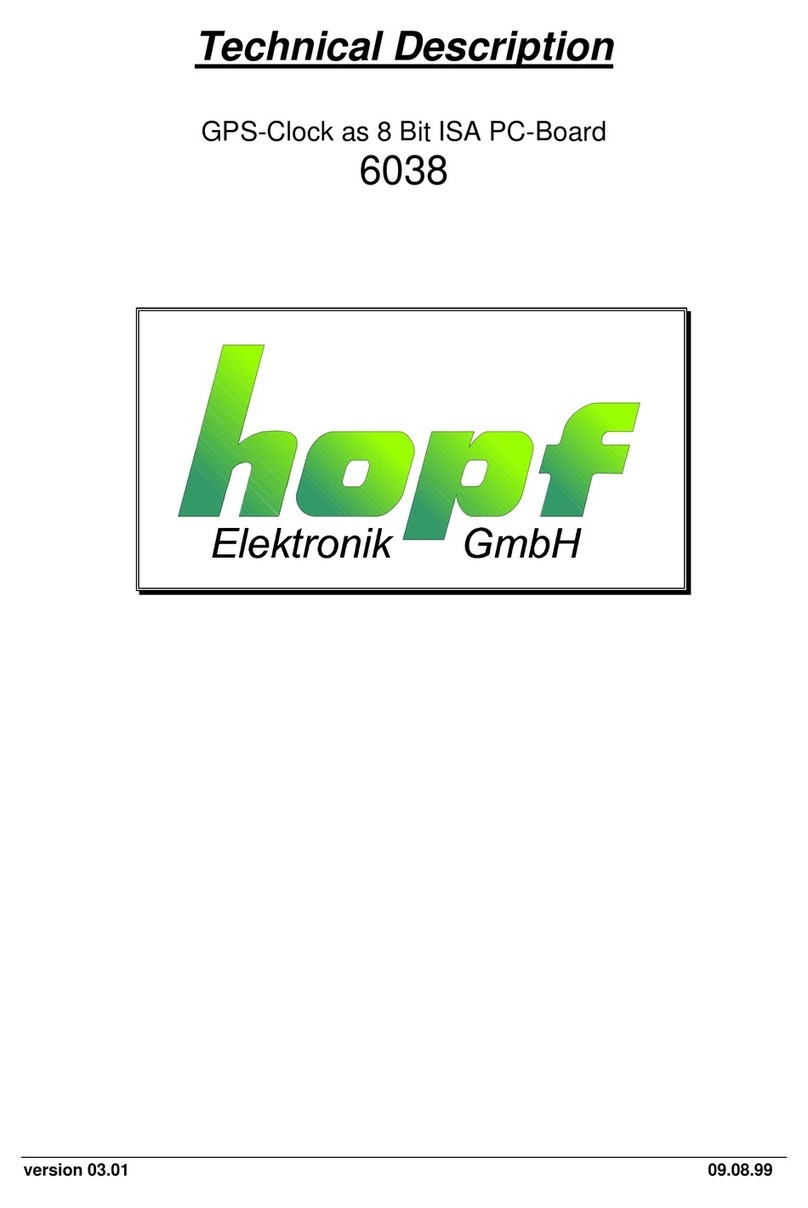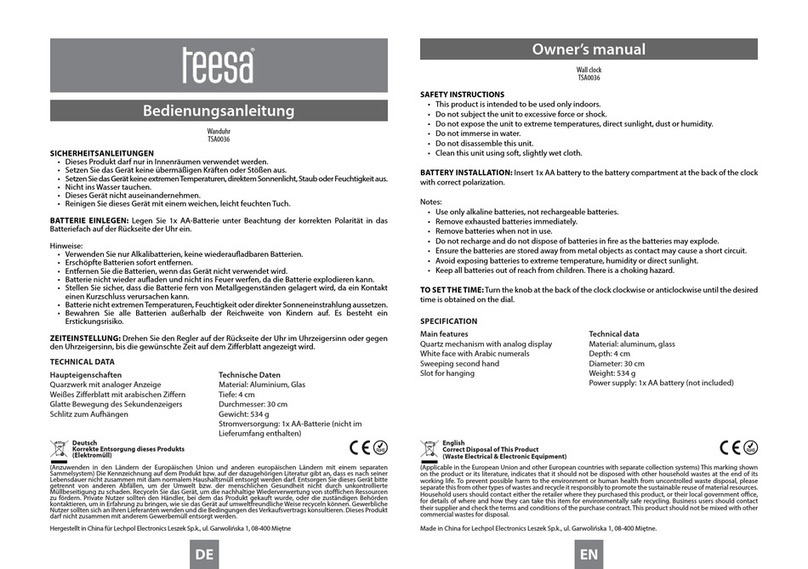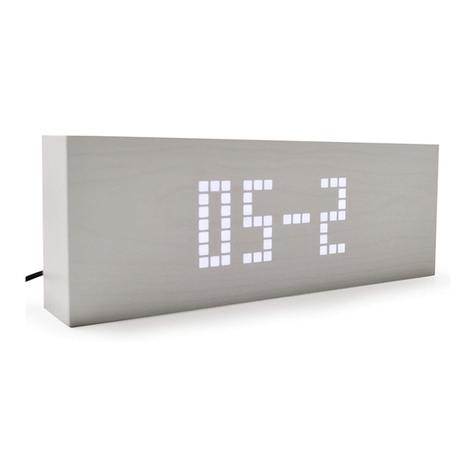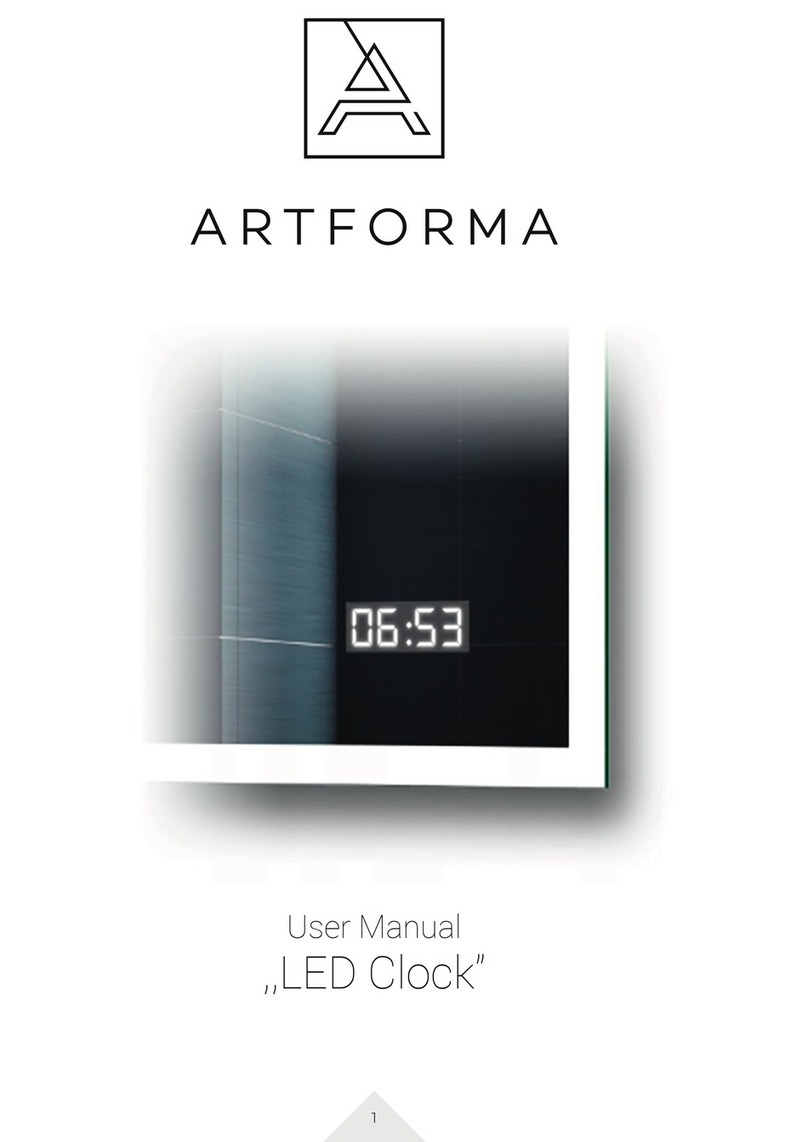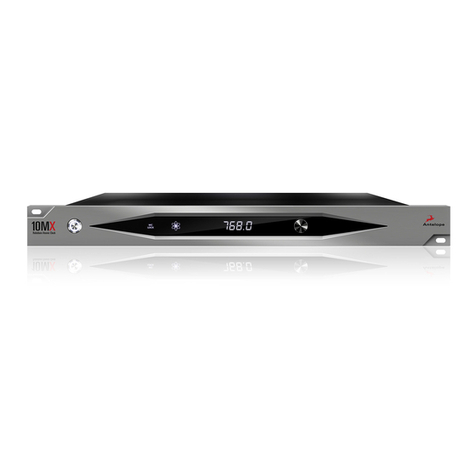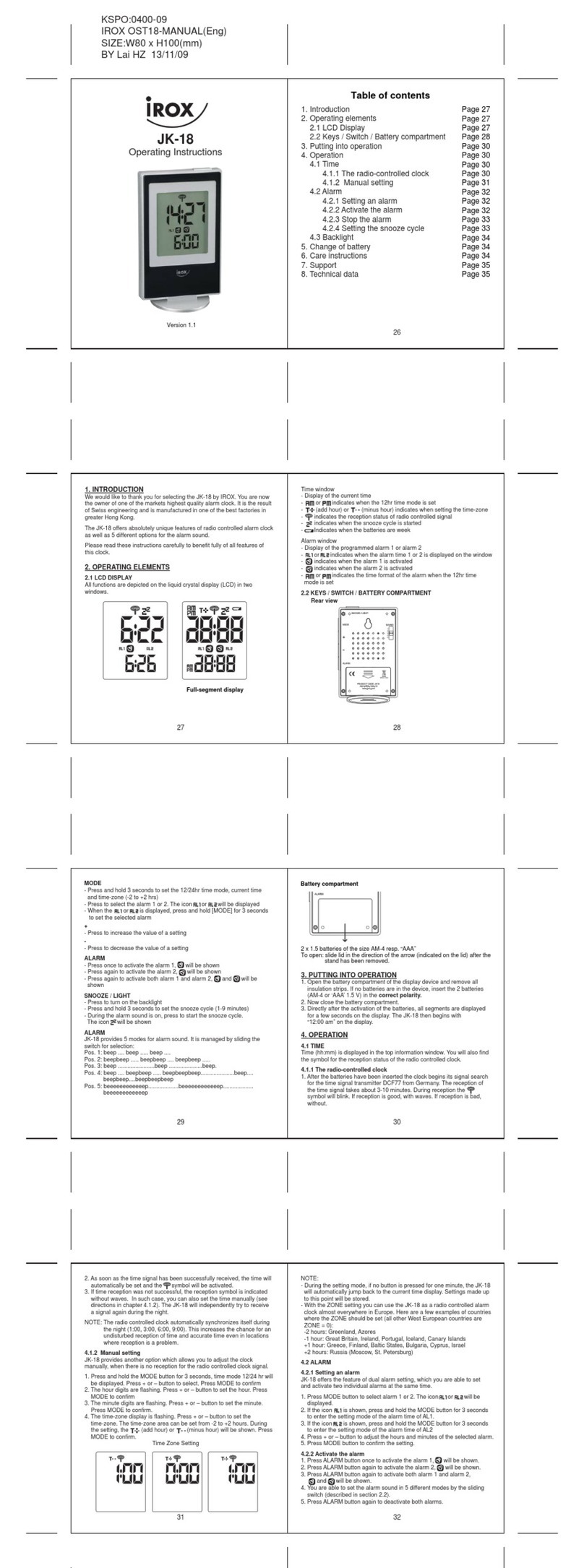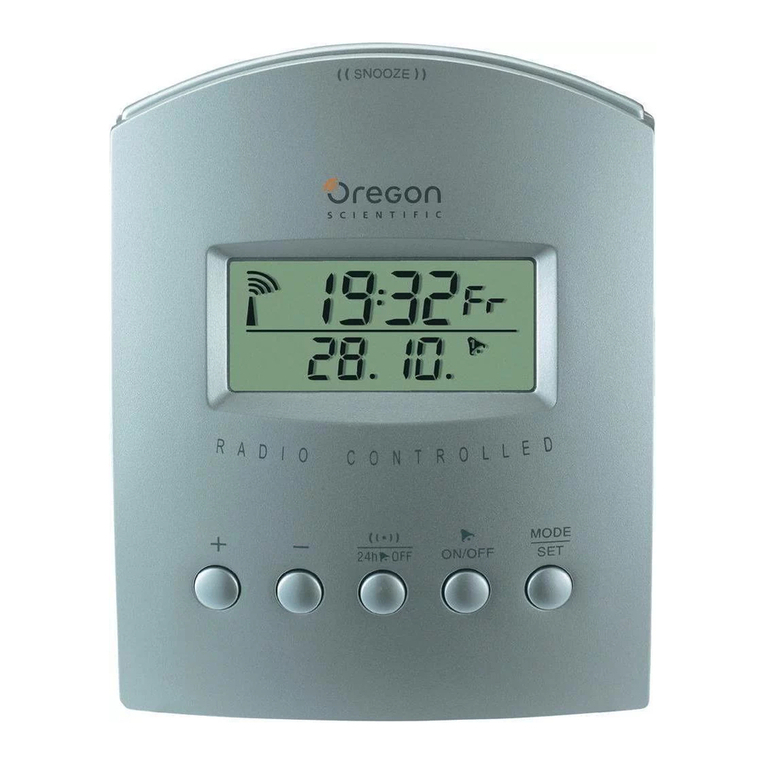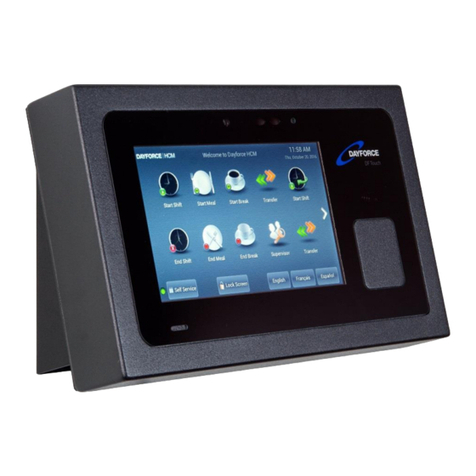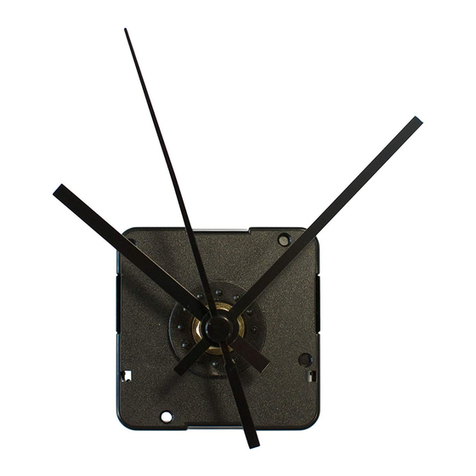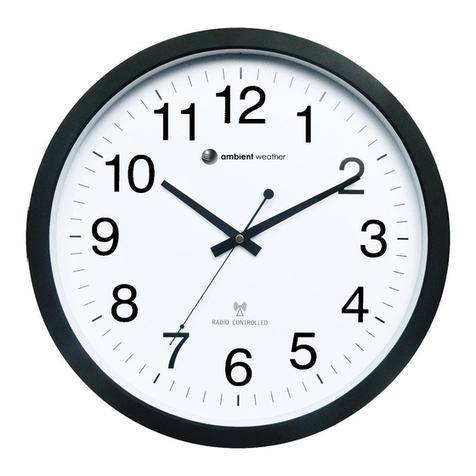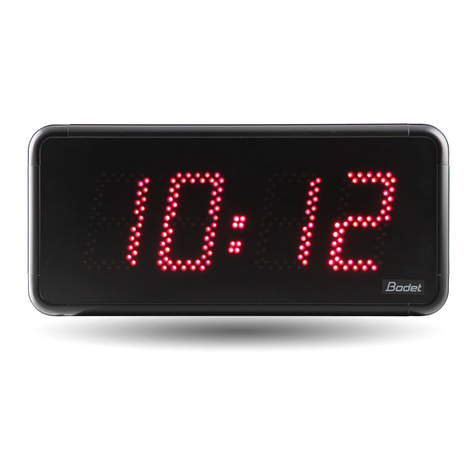Electronics Tomorrow 790E90712 User manual

INSTRUCTION MANUAL
• The configuration of your product may differ somewhat from that shown in the illustration.
• "AA" or "AAA" size battery. This product may use more than one piece of battery. Please refer to
the engraved battery marks inside the battery compartment for the correct battery type.
Locations of Control
Main Unit (Receiver)
WAVE BUTTON
-BUTTON
+BUTTON
SET BUTTON
RE-SYNC BUTTON
DST / TIME ZONE BUTTON
RESET BUTTON
°C/°F BUTTON
A
B
C
D
E
F
G
H
CG D BA HF E
Remote Unit (Transmitter)
RESET BUTTON
°C/°F BUTTON
A
B
B
A
REMOTE

What is Radio Controlled Clock
With the Radio-Controlled Clock, you have the most accurate timepiece within the
continent. It can receive the time signal transmitted by the National Institute of Standards
and Technology ( NIST ), which is regulated by 3 atomic clocks and deviate less than 1
second within 3,000 years.
The NIST broadcasts the time signal ( WWVB, 60kHz ) continuously from Fort Collins,
Colorado. This signal can be received anywhere in the continental USA that long wave (AM)
radio reception is possible with a portable radio. It is expected that the signal can reach a
distance of 2,000 miles from the transmitter. Therefore, your clock will receive the signal
within the broadcast range anywhere an AM signal can be received; generally the signal
cannot be picked up in massive metal and concrete structures unless near a window. In
addition, some environmental effect ( see below ) may affect the transmitting distance.
For more information, please study the WWVB WEB page of NIST at :
http://www.boulder.nist.gov/timefreq/
Environmental Reception Effects
The Radio-Controlled Clock obtains the accurate time with wireless technology. Same as
all wireless devices, the receiving ability may be affected by, but not limited to, the following
conditions:
• Long transmitting distance.
• Nearby mountains and valleys.
• Among tall buildings.
• Near railway, high voltage cable, etc.
• Near freeway, airport, etc.
• Near construction site.
• Inside concrete buildings.
• Near electrical appliances.
• Bad weather.
• Inside moving vehicles.
• Nearby metallic structures.
P. 2

Feature
• Receive 60kHz WWVB signal transmitted by NIST at Fort Collins Colorado
• Automatic time adjustment after signal reception
• Calendar with day of the week display
• Hour, minute and second display
• Indoor temperature and remote temperature
• Centigrade or Fahrenheit readout
• Indoor temperature measurement range from -20°C ~ 70°C ( -4°F ~ 158°F )
• Outdoor temperature measurement range from -50°C ~ 70°C ( -58°F ~ 158°F )
• Temperature resolution 0.1°C ( 0.2°F )
• Clock operation temperature from 0°C ~ 50°C ( 32°F ~ 122°F )
• Time accuracy ( Atomic clock ) : better than 1 second in 2 million years
• Time accuracy ( free run ) : within +/-60second per month
Location Precautions
This clock receives a radio wave much like a TV or radio. Be sure to locate it near a window or
some other locations where reception is good.
Avoid the following locations, which can interfere with proper reception.
Before You Begin
To ensure proper functioning of the unit, please follow this set up procedure.
• Insert batteries for the main unit ( Refer to section of Battery Installation )
• Place the main unit as close as possible next to the remote unit and insert batteries for the
remote unit.
• Position the remote unit and main unit within effective transmission range, which in usual
circumstances is 30 to 45 meters.
Note that the effective range is affected by the building materials and where the main and
remote unit are positioned, try various setup for the best results.
Inside or near concrete/ steel bulidings
or structures, unless the clock is close/
next to a window (with curtain open).
Too close to household appliances
(Computer, TV, video/audios, fax
machines, speakers).
Near construction sites, traffic lights,
roadside, neon lights etc.
Inside moving vehicles (automobile, train, airplanes
etc) which radio transmission or electronics will
interfere the reception of radio-controlled clock.
Close to or on top of metal surfaces / plates.
Next or close to power station.

Battery Installation
Battery Installation of the Main Unit
• Open the battery door.
• Load full set (2pcs AA size battery) of new batteries in polarity (+) and (-) as indicated.
• Close the battery door.
Battery Installation of the Remote Unit
• Open the battery door.
• Load full set (2pcs AA size battery) of new batteries in polarity (+) and (-) as indicated.
• Close the battery door.
Warning : Do not mix old and new batteries.
Do not mix alkaline, standard (carbon-zinc) or rechargeable (nickel cadmium)
batteries.
Do not touch any other button or setting on your main unit. It will automatically receive the
remote temperature and time signal after batteries inserted.
Getting Started
Thermometer
Upon power up of the remote unit ( or pressing the RESET button ), the temperature RF
signal is immediately sent to the main unit. The main unit attempts to search the RF tempera-
ture signal for 5 minutes after power up ( or pressing the RESET button ).
If the RF signal is received within the first 5 minutes after power up of the main unit, the
temperature will show on the remote temperature display, otherwise it will show blank “--.-ºC”.
After the remote unit temperature is shown on the remote temperature display, the synchroni-
zation of main unit and remote unit is established. Afterward place the remote units outside in
a shaded, dry area to protect it as if under an umbrella.
If the RF temperature signal is not received within the first 5 minutes, press the RE-SYNC
button on the main unit, the main unit will attempt remote temperature for another 6 minutes.
Radio Controlled Clock
As long as batteries are supplying power to the main unit, it receives the time signal and
adjust time automatically. No manual adjustment is required after power up. Accurate adjust-
ment of the clock based on the time signal is supported in the continental USA.
You are recommended to leave the clock overnight for seaching time signal since night time
allows better transmission of time signal.
P. 4

Wave Signal Receive Operation
The main unit automatically receives time signal everyday at 02:00am and makes any
required adjustment to the time setting, indicated by the flashing tower icon .
If the time signal is successfully received, the tower icon will stop flashing and will display
steadily. A WAVE OK indicator will appear on display.
Important : Do not perform any button or switch operation while a signal receive operation is
in progress.
Triggering a Wave Receive Operation manually
You can trigger a signal receive operation at any time by pressing the WAVE button, which
cause the main unit to perform an immediate signal receive operation.
Unsuccessful Wave Signal Reception
If the automatic updates at 2:00am are unsuccessful, the wave on top of the antenna tower
and the WAVE OK icon will disappear.
If unsuccessful signal reception after battery installation or after reset, the main unit will keep
trying for 10 minutes every hour until time signal reception is successful.
Manually Set the Clock
To Set DST
• Press and hold the “DST/TIME ZONE” button until On or Off display on LCD.
• Press “+” or “
-
” button to toggle between DST ON and DST OFF.
• Press “DST/TIME ZONE” button to confirm and leave setting mode.
To Set TIME ZONE
• Press “DST/TIME ZONE” sequentially to select your local time zone
To Set the Calendar
1. Press and hold SET button to active calendar set mode.
2. Press + or – button sequentially to set year.
3. Holding down either + or – button to change the year at high speed.
4. Press SET button to confirm year set and go to date set.
5. Press + or – button sequentially to set date.
6. Holding down either + or – button to change the date at high speed.
To Set the Time
1. Press SET button after calendar set mode.
2. Press + or – button sequentially to set minutes, when you press the + or – button once,
the seconds count reset to 00.
3. Holding down either + or – button to change the time at high speed.
4. Press SET button after desired time set and go to time format set mode.
5. Press + or – button to toggle between 12hr and 24 hr time display format.
6. Press SET button to confirm and quit the set mode.

NO SIGNAL DETECTION
SIGNAL DETECTION
SUCCESSFUL RECEPTION
Check IN / REMOTE Temperature
The indoor temperature is displayed on the INDOOR temperature field and the OUTDOOR
temperature will be shown on the OUTDOOR temperature field.
Display Unit
The default unit for temperature is °C, press °C/°F button will toggle the display unit of
temperature between °C and °F.
Receiver Stage Indicator
The RF signal indicator in the base unit remote temperature window will show the following:
Losing Synchronization of the Wireless Thermometer
If the base unit displayed a proper remote temperature in the past but now displays blank “--“,
the remote unit and the main unit may have lost synchronization. If this occurs, press the
RE-SYNC button of the main unit. The main unit will attempt outdoor temperature reception for
another 6 minutes and reinitiate synchronization with the remote unit. If the remote tempera-
ture cannot be received, check:
1. The distance of the main unit or remote unit should be at least 3-4 feet away from any
interfering sources such as computer monitors or TV sets.
2. Avoid placing the main unit onto or in the immediate proximity of metal window frames.
3. Using other electrical products such as headphones or speaker operating on the same
signal frequency ( 433MHz ) may prevent correct signal transmission and reception.
4. Neighbors using electrical devices operation on the 433MHz signal frequency can also
cause interference.
Note: When the 433MHz signals is received correctly, do not re-open the battery cover of
either the remote unit or the main unit, as the batteries may spring free from the contacts and
force a false reset. Should this happen accidentally then reset both unit otherwise transmission
problems may occur.
The maximum transmission range is 150 feet from the remote unit to the main unit ( in open
space ). However, this depends on the surrounding environment and interference levels. The
temperature signal travels in a straight line from the remote unit to the clock. The signal will not
curve around blocking object. If no reception is possible despite the observation of these
factors, all unit have to be reset.
P. 6

Wall Mounting or Using the Stand
The main unit has a built in stand, you can flip open to support the main unit on a flat surface.
You can close the flip and mount the unit on a wall. Drive a screw into the wall until the head
extends about 1/8 inch from the wall, then locate the keyhole slot over the screw head and
slide the Atomic Clock down to make it secure.
The remote unit comes with a wall mount holder which can hold the unit on wall, or just place it
on a flat surface.
Interference
Signals from other household devices, such as entry controls, door bells and home security
systems, may temporarily interfere with the units and cause reception failure. This is normal
and does not affect the general performance of the product. The transmission and reception of
temperature reading will resume once the interference has stopped.
Trouble Shooting
• Press the RESET button when the clock is displaying irrelevant time even when the tower
icon shows. This may happen when the external noise is severe enough to interfere with the
time signal.
• Press the RESET button on the transmitter if the readout is irrelevant or does not respond.
Care of Your Clock
• Avoid exposing your clock to extreme temperatures, water or severe shock.
• Avoid contact with any corrosive materials such as perfume, alcohol or cleaning agents.
• Do not subject the clock to excessive force, shock, dust, temperature or humidity. Any of
these conditions may shorten the life of the clock.
• Do not tamper with any of the internal components of this clock. This will invalidate the
warranty and may cause damage.
REMOTE

Specification
Temperature Operation Range
Receiver : 0°C to +40°C
32°F to 104°F
Transmitter : 0°C to +40°C
32°F to 104°F
Receiver : every 32 seconds
Transmitter : every 16 seconds
Temperature Checking Interval
Receiver : every 32 seconds
Transmitter : every 16 seconds
Transmission Distance: maximum 45m in open field, depending upon surrounding structures,
mounting location and possible interfering sources.
Power Source ( Alkaline batteries recommended )
Receiver : 2 "AA" batteries, 1.5V batteries
Transmitter : 2 "AA" batteries, 1.5V batteries
Battery life : about 12 months
Dimension ( L x W x H )
Receiver : 146 x 31 x 84 mm
Transmitter : 75 x 22.5 x 82 mm
This device complies with Part 15 of the FCC rules. Operation is subject to the following two
conditions: (1) This device may not cause harmful interference, and (2) This device must
accept any interference received, including interference that may cause undesired operation.
Warning: Changes or modifications to this unit not expressly approved by the party respon-
sible for compliance could void the user’s authority to operate the equipment.
NOTE: This equipment has been tested and found to comply with the limits for a Class B
digital device, pursuant to Part 15 of the FCC Rules. These limits are designed to provide
reasonable protection against harmful interference in a residential installation. This equipment
generates, uses and can radiate radio frequency energy and, if not installed and used in
accordance with the instructions, may cause harmful interference to radio communications.
However, there is no guarantee that interference will not occur in a particular installation. If this
equipment does cause harmful interference to radio or television reception, which can be
determined by turning the equipment off and on, the user is encouraged to try to correct the
interference by one or more of the following measures:
• Reorient or relocate the receiving antenna.
• Increase the separation between the equipment and the receiver.
• Connect the equipment into an outlet on a circuit different from that to which the receiver is
connected.
• Consult the dealer or an experienced radio/TV technician for help.
Table of contents
Other Electronics Tomorrow Clock manuals
